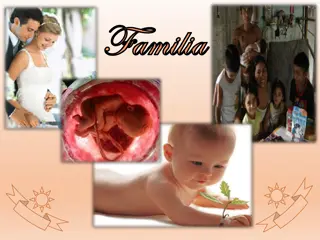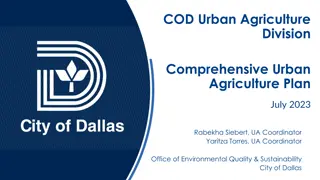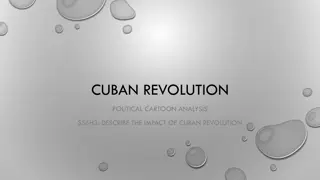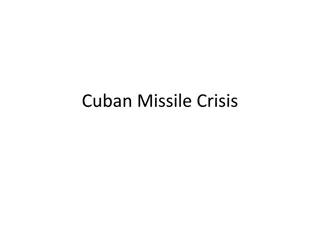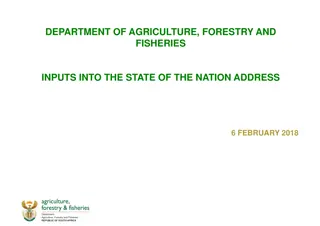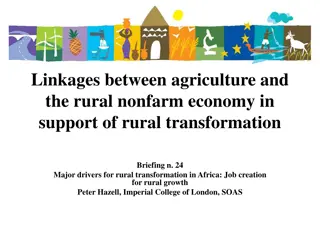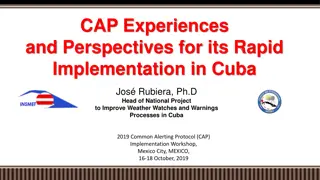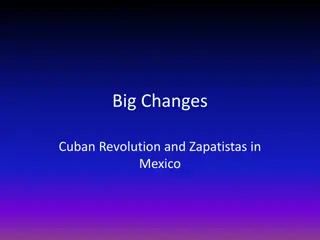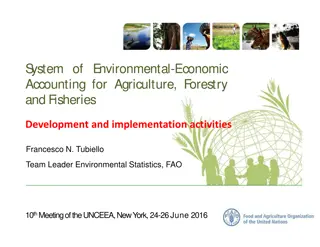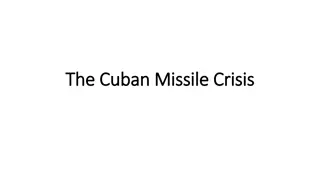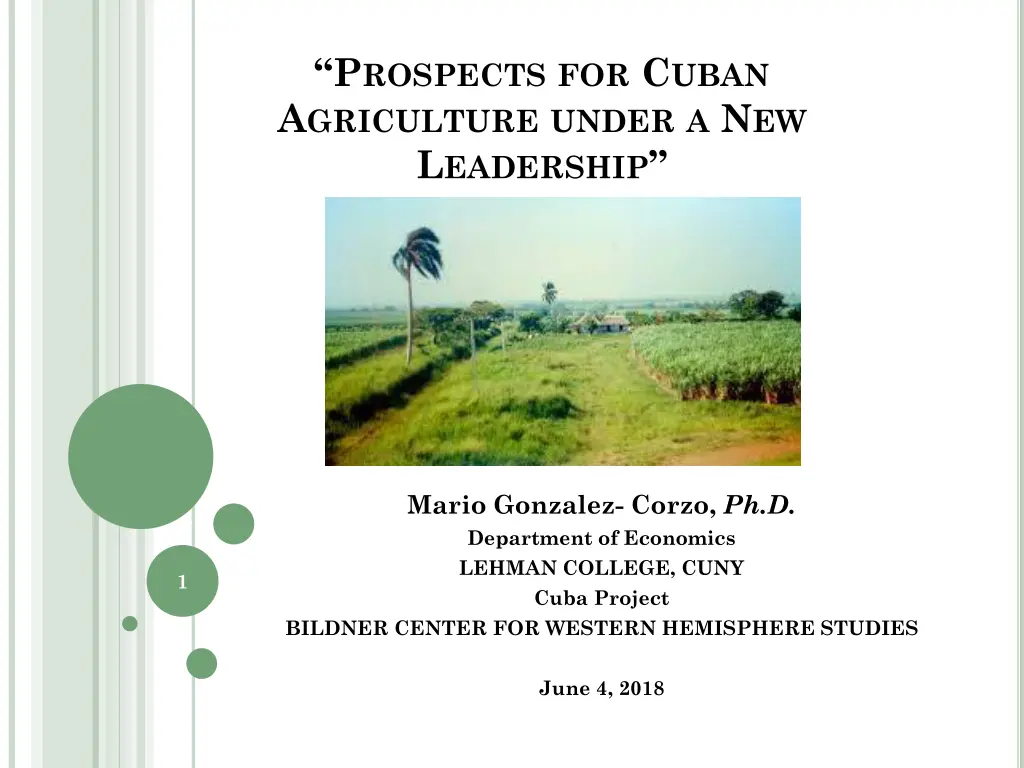
Prospects for Cuban Agriculture Reforms and Leadership Impact
Explore the current landscape of Cuban agriculture, including land distribution, employment statistics, and the impact of recent agricultural reforms. Learn about the challenges and opportunities facing Cuban agriculture under new leadership.
Download Presentation

Please find below an Image/Link to download the presentation.
The content on the website is provided AS IS for your information and personal use only. It may not be sold, licensed, or shared on other websites without obtaining consent from the author. If you encounter any issues during the download, it is possible that the publisher has removed the file from their server.
You are allowed to download the files provided on this website for personal or commercial use, subject to the condition that they are used lawfully. All files are the property of their respective owners.
The content on the website is provided AS IS for your information and personal use only. It may not be sold, licensed, or shared on other websites without obtaining consent from the author.
E N D
Presentation Transcript
PROSPECTS FOR CUBAN AGRICULTURE UNDER A NEW LEADERSHIP Mario Gonzalez- Corzo, Ph.D. Department of Economics LEHMAN COLLEGE, CUNY Cuba Project BILDNER CENTER FOR WESTERN HEMISPHERE STUDIES 1 June 4, 2018
OUTLINE I. CUBAN AGRICULTURE: SOME STYLISTIC FACTS II. CUBA S AGRICULTURAL REFORMS: 2007- PRESENT III. IMPACT OF THE REFORMS: a) EMPLOYMENT b) LAND DISTRIBUTION c) NON-SUGAR AGRICULTURAL OUTPUT d) BALANCE OF TRADE IV. PROPECTS FOR CUBAN AGRICULTURE UNDER A NEW LEADERSHIP? 2
I. CUBAN AGRICULTURE: SOME STYLISTIC FACTS Land Distribution: Cuba s total land surface is approximately 11 million hectares (ha.) Out of these, 6.2 million (ha.) (Or 56%) are dedicated to agriculture. Out of these, only 2.7 million ha. (Or 43.5%) are under cultivation. Cultivated surface: 2.7 million ha. The State sector holds 19.1% of the cultivated surface The Non-State sector holds 80.9% of the cultivated surface. UBPCs: 30.7% CPA: 9.8% CCS and Private: 40.4% Agricultural Cooperatives: (4,120 in 2017) CCS the most autonomous agricultural cooperatives, represent 58% of the total number of agricultural cooperatives in Cuba. There were 2,386 CCS in 2017. Agricultural Cooperatives account for approximately 90% of Cuba s total agricultural production, but can only satisfy about 20% of domestic demand; the rest (80%) of the food and agricultural products consumed in Cuba are imported. An estimated 30% of Cuba s domestic food production is lost on the fields due to administrative and logistical problems. Employment and Wages: There were a total of 820,900 persons employed in agriculture in 2016. They represented 18% of the total number of employed persons (in all sectors). Members or workers of agricultural cooperatives accounted for 23% of all persons employed in agriculture, and 4% of national employment. Agricultural workers earned an average monthly wage of 1,006 pesos (CUP) in 2016, compared to 746 CUP for workers in all sectors of the Cuban economy 3
II. CUBAS AGRICULTURAL REFORMS: 2007 - PRESENT Since 2007, Cuba has implemented a series of economic reforms to transform its agricultural sector. The principal goals of these reforms are: 1) increase output, and 2) reduce agricultural and food imports. The most important structural reform so far has been the transfer of idle State- owned land to non-State producers in usufruct with the approval of Decree-Law No 259 (2008) and Decree-Law No. 300 (2012) Usufruct farming, however, faces many challenges and has not produced the expected results. Other important (mostly administrative) reforms include: Moderate price reforms (2007; 2015) The consolidation of MINAL and Ministry of Fisheries and the replacement of the MINAZ with AZCUBA (2011) The authorization of the direct agricultural sales to tourism enterprises (2011) The authorization of direct agricultural sales in roadside kiosks (2011) The provision of small micro-loans by State banks to non-State agricultural producers (2011) Liberalization of the commercialization of selected agricultural products (2011) More recently in 2017 the Cuban government announced that starting in 2018, it will apply Law No. 113 (approved in 2012) to collect taxes from usufruct farmers and from idle or non-productive agricultural lands held by usufruct farmers. The tax regime established by Law 113 (2012) is expected to be enforced sometime this year (i.e., 2018). 4
III. IMPACTOFTHEREFORMS A ) Employment Due to demographic factors (e.g. emigration, low birth rates, and the aging of the population), and economic factors (e.g. insufficient wages, unsatisfactory working conditions, etc.), total employment (in the Cuban economy) has declined in recent years. General Employment Trends Between 2010 and 2016: Total employment fell 8%, from 4,984, 500 in 2010 to 4,591,100 in 2016. Agricultural employment declined 11%, from 921,500 in 2010 to 820, 900 in 2016. Employment in agricultural cooperatives (CCS, CPA, and UBPC) decreased 12.5%, from 217,000 in 2010 to 189,900 in 2016. Agriculture s Share of Employment: 2010 2016: In 2010, agriculture accounted for 18.5% of total employment in Cuba; and 23.5% of agricultural Workers were employed by cooperatives (CCS, CPA, and UBPC). In 2016, agriculture accounted for 18% of total employment; 23% of agricultural workers were employed by cooperatives (CCS, CPA, and UBPC), and 35% were registered as usufruct farmers. However, the reported number of active usufruct farmers in 2016 was estimated at 150,000, or 18.3% of all agricultural workers 5
III. IMPACTOFTHEREFORMS B) Land Distribution Table 1: Cuba: Land distribution based on tenure form, 2007 and 2016 2007 State Sector Total 6,088.90 2,371.20 694.2 1,677.00 627.2 Non-State Sector Thousand Hectares Total Land Surface Agricultural Land Cultivated Land Non-Cultivated Land Idle Land 2014 Thousand Hectares Total Land Surface Agricultural Land Cultivated Land Non-Cultivated Land Idle Land Total 10,988.60 4,415.50 2,988.50 3,631.00 1,232.80 Total 4,899.70 2,044.30 2,294.30 1,954.00 605.6 UBPC 2,804.80 244.2 1,189.90 1,258.30 465.4 CPA 692.8 585.8 305.3 280.5 73.4 CCS and Private 1,402.10 1,214.30 799.1 415.2 66.8 Total 10,988.40 6,226.70 2,733.50 4,761.70 n.a Total 6,080.50 1,912.00 521.9 4,168.50 n.a Total 4,907.90 4,314.70 2,211.60 593.20 n.a UBPC 1,782.30 1,528.40 840.4 253.9 n.a CPA 509.3 503 267.3 6.3 n.a. CCS and Private 2,616.30 2,283.30 1,103.90 333.00 n.a The agricultural reforms introduced since 2007 have contributed to increases in the share of Land held by the Non-State sector: 2007: The Non-State sector held 46% of the agricultural land and 77% of the cultivated land. CCS (the most autonomous coops) held 59% of the agricultural land and 35% of the cultivated land held by the Non-State sector. 2016 (based on data published in 2014): The Non-State sector held 69% of the agricultural land and 97% of the cultivated land. CCS held 55% of the agricultural land and 50% of the cultivated land held by the Non-State sector. 6
III. IMPACTOFTHEREFORMS c) Non- Sugar Agricultural Production Increases in Output 3,500,000 3,000,000 2,500,000 Viandas(a) Plantains 2,000,000 Cereals 1,500,000 Decreases in Output Legumes 1,000,000 Other Fruits Cocoa 500,000 0 3,000,000 2,500,000 2,000,000 Vegetables 1,500,000 Tobacco Citrus Fruits 1,000,000 500,000 7 0 2008 2009 2010 2011 2012 2013 2014 2015 2016
III. IMPACTOFTHEREFORMS c) Non- Sugar Agricultural Production CCS and private farmers account for more than 70% of total output, except for Potatoes and Citrus Fruits The Non-State sector accounts for more than 80% of total output, except for Potatoes and Citrus Fruits The State sector accounts for a relatively small share of total output Table 2. Cuba - Dynamics of Non-Sugar Agricultural Production by Sector, 2017 Percentage of Total Output State Sector Total 11.5% 10.4% 9.2% 35.6% 12.6% 12.8% 9.2% 19.0% 5.4% 12.2% 53.0% 7.8% Non -State Sector CROPS Total Output (Mt) 5,327.5 2,843.8 1,828.9 147.0 1,014.9 2,483.7 584.1 404.7 373.9 132.2 98.8 926.2 Total 88.5% 89.6% 90.8% 64.4% 87.2% 87.2% 90.8% 81.0% 94.6% 87.8% 47.0% 92.2% UBPC 5.8% 7.8% 8.4% 36.8% 17.7% 3.4% 6.8% 3.8% 12.8% 7.0% 8.1% 10.3% 3.4% CPA CCS and Private 3.7% 4.6% 5.4% Viandas and Vegetables 79.0% 77.2% 77.0% 9.8% 81.0% 77.5% 83.0% 63.8% 84.3% 75.1% 35.4% 86.9% Viandas Roots and Tubers Potatoes Plantains Vegetables Tomatoes 2.7% 3.1% 4.0% 4.5% 3.3% 4.6% 1.2% 2.0% Rice Corn Beans Citrus Fruits Various Fruits 8
III. IMPACTOFTHEREFORMS d) Balance of Trade: Agricultural EX and IM Fig. 1 - Cuba: Agricultural EX and IM, 2011-2016 2,500,000 2,000,000 (Thousand Pesos) 1,500,000 1,000,000 500,000 0 2011 2012 2013 2014 2015 2016 Food and Agricultural Products (EX) Food and Agricultural Products (IM) 482,568 570,329 249,367 507,848 522,911 454,097 1,863,194 1,644,877 1,848,051 1,917,741 1,800,910 1,777,569 Despite ongoing efforts to substitute food and agricultural imports, Cuba remains highly dependent on the external sector to meet the nutritional needs of its 11.2 million population. The island currently imports 80% of all the food and agricultural products consumed by its population. 2011: Agricultural imports reached $1.8 billion USD, representing 13.4% of Cuba s total merchandise imports. 9 2016 Agricultural imports reached $1.78 billion USD, representing 17.3% of Cuba s total merchandise imports.
IV. PROPECTS FOR CUBAN AGRICULTURE UNDER A NEW LEADERSHIP? Since the collapse of the Socialist Bloc and the disintegration of the Soviet Union in the early 1990s, Cuba s agricultural sector has been affected by declining output levels, low labor productivity, worker absenteeism, insufficient administrative coordination, excessive bureaucratic controls, and increasing de-capitalization caused by shortages of investment and foreign exchange receipts (Hagelberg, 2010; Spadoni, 2014). Cuban agriculture has also been impacted by adverse weather conditions, particularly several devastating hurricanes and a severe drought (2006-2008) and the effects of the U.S. trade embargo (Gonz lez-Corzo 2013, Mesa-Lago, 2012; 2013; Nova Gonz lez, 2013; Spadoni, 2014). In May 2018, Hurricane Alberto severely affected the central provinces of Cienfuegos, Villa Clara, and Sancti Spiritus. According to (Nova Gonz lez, 2013), there are three (3) fundamental unresolved aspects that which have significantly limited the impact of the agricultural reforms initiated in 2007: (1) the need to achieve the complete (or full) realization of property, (2) the necessity to recognize and accept the existence of the market and its complementary role in the coordination of economic activities, and (3) the absence of a systematic approach across the entire agricultural production- consumption cycle to strengthen micro and macroeconomic linkages THESE ISSUES REMAIN UNRESOLVED, AND NEED TO BE URGENTLY ADDRESSED BY THE NEW LEADERSHIP! In addition, to achieve sustainable levels of progress, more profound structural reforms are needed, such as: 1) expansion of private property rights, 2) opening agriculture to FDI, 3) competitive input markets, 4) freedom to contract labor and invest capital, 5) elimination of price controls and other distortions, and 6) unleashing the productive potential by allowing the market to function as the primary coordinating mechanism in the economy. Only time will tell if Cuba s the New Leadership will have the political necessary will to implement the profound structural changes urgently needed to revive Cuban agriculture. 10


